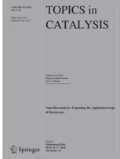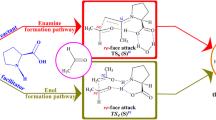Abstract
The full catalytic cycle of the proline-catalyzed intermolecular aldol reaction of acetone and p-nitrobenzaldehyde in acetone solvent has been investigated by quantum chemistry at the G3(MP2,CC)//M062X/6–31+G(d)/SMD level of theory, and the results used to develop an ab initio kinetic model. Proline catalyzes the aldol reaction according to the enamine mechanism. The initial reaction between proline and acetone was reinvestigated, and a revised mechanism for enamine formation is proposed in which a second proline assists the process contributing to the enamine formation. Using various initial concentrations of proline while keeping the experimental ratio of water, aldehyde and acetone constant, we find that the enamine formation from the first-order to proline pathway dominates when the concentration of proline is low (< 0.005 M); while the second-order enamine formation pathways contribute and then dominate as the proline concentration is increased. The relative rates of formation of the syn and anti-enamine are not important, as these interconvert via C–N bond rotation and equilibrate faster than their subsequent reaction, which follows the standard Houk/List mechanism. While the stereochemistry can be predicted from an analysis of the alternative C–C bond formation pathways, their relative contributions to the major and minor product yields are influenced by their subsequent rates of hydrolysis. Indeed, while C–C bond formation is normally considered rate determining, our kinetic simulations show that the kinetic model is more complicated than this and under typically used concentrations, the process of initial enamine formation, C–C bond formation and the initial stages of product release all contribute to the overall reaction rate. Using our kinetic model, we predict that yield and %ee are optimal for concentrations of [proline] = 0.005 M, [acetone] = 2.25 M, [aldehyde] = 0.1 M, and [water] = 0.6 M. Using excess acetone (up to 2.6 M) increases both conversion and %ee. Excess aldehyde increases %ee but decreases conversion, and excess catalyst increases the conversion but decreases %ee. Aside from the indirect effect of increasing the solubility of the proline catalyst, water increases both conversion and %ee up to a point, but at large concentrations (> 1.0 M) excess water is expected to decrease %ee. Side reactivity, including aldol condensation, acetone self-aldolization, oxazolidinone formation and azomethine and 1-oxapyrrolizidine formation were all considered in our kinetic model but shown to have a negligible effect (< 2%) on the yield and %ee over the full range of reaction conditions investigated.
Graphic Abstract













Similar content being viewed by others
References
Eder U, Sauer G, Wiechert R (1971) New type of asymmetric cyclization to optically active steroid CD partial structures. Angew Chem Int Ed 10:496–497
Hajos ZG, Parrish DR (1974) Asymmetric synthesis of bicyclic intermediates of natural product chemistry. J Org Chem 39:1615–1621
List B, Lerner RA, Barbas CF (2000) Proline-catalyzed direct asymmetric aldol reactions. J Am Chem Soc 122:2395–2396
Jung ME (1976) A review of annulation. Tetrahedron 32:3–31
Puchot C, Samuel O, Dunach E, Zhao S, Agami C, Kagan H (1986) Nonlinear effects in asymmetric synthesis. Examples in asymmetric oxidations and aldolization reactions. J Am Chem Soc 108:2353–2357
List B, Hoang L, Martin HJ (2004) New mechanistic studies on the proline-catalyzed aldol reaction. Proc Natl Acad Sci USA 101:5839–5842
Bahmanyar S, Houk KN (2001) Transition states of amine-catalyzed aldol reactions involving enamine intermediates: theoretical studies of mechanism, reactivity, and stereoselectivity. J Am Chem Soc 123:11273–11283
Bahmanyar S, Houk KN (2001) The origin of stereoselectivity in proline-catalyzed intramolecular aldol reactions. J Am Chem Soc 123:12911–12912
Bahmanyar S, Houk KN (2003) Origins of opposite absolute stereoselectivities in proline-catalyzed direct Mannich and aldol reactions. Org Lett 5:1249–1251
Bahmanyar S, Houk KN, Martin HJ, List B (2003) Quantum mechanical predictions of the stereoselectivities of proline-catalyzed asymmetric intermolecular aldol reactions. J Am Chem Soc 125:2475–2479
Clemente FR, Houk KN (2004) Computational evidence for the enamine mechanism of intramolecular aldol reactions catalyzed by proline. Angew Chem 116:5890–5892
Zhu H, Clemente FR, Houk KN, Meyer MP (2009) Rate limiting step precedes C–C bond formation in the archetypical proline-catalyzed intramolecular aldol reaction. J Am Chem Soc 131:1632–1633
Armstrong A, Boto RA, Dingwall P, Contreras-García J, Harvey MJ, Mason NJ, Rzepa HS (2014) The Houk-List transition states for organocatalytic mechanisms revisited. Chem Sci 5:2057–2071
Rajagopal D, Moni M, Subramanian S, Swaminathan S (1999) Proline mediated asymmetric ketol cyclization: a template reaction. Tetrahedron Asymmetry 10:1631–1634
Rankin KN, Gauld JW, Boyd RJ (2002) Density functional study of the proline-catalyzed direct aldol reaction. J Phys Chem A 106:5155–5159
Arnó M, Domingo LR (2002) Density functional theory study of the mechanism of the proline-catalyzed intermolecular aldol reaction. Theor Chem Acc 108:232–239
Ajitha MJ, Suresh CH (2011) A higher energy conformer of (S)-proline is the active catalyst in intermolecular aldol reaction: evidence from DFT calculations. J Mol Catal A Chem 345:37–43
Sharma AK, Sunoj RB (2010) Enamine versus oxazolidinone: what controls stereoselectivity in proline-catalyzed asymmetric aldol reactions? Angew Chem Int Ed 122:6517–6521
Yu L-J, Coote ML (2021) Electrostatic switching of stereoselectivity in aldol reactions. J Org Chem 86:9076–9083
Bock DA, Lehmann CW, List B (2010) Crystal structures of proline-derived enamines. Proc Natl Acad Sci USA 107:20636–20641
Schmid MB, Zeitler K, Gschwind RM (2010) The elusive enamine intermediate in proline-catalyzed aldol reactions: NMR detection, formation pathway, and stabilization trends. Angew Chem 49:4997–5003
Zotova N, Franzke A, Armstrong A, Blackmond DG (2007) Clarification of the role of water in proline-mediated aldol reactions. J Am Chem Soc 129:15100–15101
Zotova N, Broadbelt LJ, Armstrong A, Blackmond DG (2009) Kinetic and mechanistic studies of proline-mediated direct intermolecular aldol reactions. Bioorg Med Chem Lett 19:3934–3937
Zotova N, Moran A, Armstrong A, Blackmond DG (2009) A coherent mechanistic rationale for additive effects and autoinductive behaviour in proline-mediated reactions. Adv Synth Catal 351:2765–2769
Mathew SP, Klussmann M, Iwamura H, Wells JDH, Armstrong A, Blackmond DG (2006) A mechanistic rationalization of unusual kinetic behavior in proline-mediated C–O and C–N bond-forming reactions. Chem Commun. https://doi.org/10.1039/B609926B
Hoang L, Bahmanyar S, Houk KN, List B (2003) Kinetic and stereochemical evidence for the involvement of only one proline molecule in the transition states of proline-catalyzed intra-and intermolecular aldol reactions. J Am Chem Soc 125:16–17
Orsini F, Pelizzoni F, Forte M, Sisti M, Bombieri G, Benetollo F (1989) Behaviour of aminoacids and aliphatic aldehydes in dipolar aprotic solvents: Formation of oxazolidinones—behaviour of aminoacids and aliphatic aldehydes in dipolar aprotic solvents. J Heterocycl Chem 26:837–841
Seebach D, Beck AK, Badine DM, Limbach M, Eschenmoser A, Treasurywala AM, Hobi R, Prikoszovich W, Linder B (2007) Are oxazolidinones really unproductive, parasitic species in proline catalysis?—Thoughts and experiments pointing to an alternative view. Helv Chim Acta 90:425–471
Frisch M, Trucks G, Schlegel H, Scuseria G, Robb M, Cheeseman J, Scalmani G, Barone V, Petersson G, Nakatsuji H et al (2016) Gaussian 09, Revision E 01. Gaussian Inc, Wallingford CT
Werner H, Knowles P, Knizia G, Manby F, Schütz M, Celani P, Györffy W, Kats D, Korona T, Lindh R, al. e (2015) MOLPRO, version 2015.1, a package of ab initio programs.
Izgorodina EI, Lin CY, Coote ML (2007) Energy-directed tree search: an efficient systematic algorithm for finding the lowest energy conformation of molecules. Phys Chem Chem Phys 9:2507–2516
Ho JM, Klamt A, Coote ML (2010) Comment on the correct use of continuum solvent models. J Phys Chem A 114:13442–13444
Marenich AV, Cramer CJ, Truhlar DG (2009) Universal solvation model based on solute electron density and on a continuum model of the solvent defined by the bulk dielectric constant and atomic surface tensions. J Phys Chem B 113:6378–6396
Xu L, Coote ML (2019) Methods to improve the calculations of solvation model density solvation free energies and associated aqueous pKa values: comparison between choosing an optimal theoretical level, solute cavity scaling, and using explicit solvent molecules. J Phys Chem A 123:7430–7438
Zhao Y, Truhlar DG (2008) The M06 suite of density functionals for main group thermochemistry, thermochemical kinetics, noncovalent interactions, excited states, and transition elements: two new functionals and systematic testing of four M06-class functionals and 12 other functionals. Theor Chem Acc 120:215–241
Alecu I, Zheng J, Zhao Y, Truhlar DG (2010) Computational thermochemistry: scale factor databases and scale factors for vibrational frequencies obtained from electronic model chemistries. J Chem Theory Comput 6:2872–2887
Curtiss LA, Raghavachari K, Redfern PC, Baboul AG, Pople JA (1999) Gaussian-3 theory using coupled cluster energies. Chem Phys Lett 314:101–107
O’Neil MJ (ed) (2018) The Merck Index - An Encyclopedia of Chemicals, Drugs, and Biologicals. Royal Society of Chemistry, Cambridge, UK
Wolfram Research I (2019) Mathematica. Version, 12.0. Wolfram Research, Inc., Champaign, Illinois
Blyth MT, Coote ML (2019) A pH-Switchable Electrostatic Catalyst for the Diels-Alder Reaction: Progress toward Synthetically Viable Electrostatic Catalysis. J Org Chem 84:1517–1522
Tóth J, Nagy AL, Papp D (2018) The Induced Kinetic Differential Equation. In: Tóth J, Nagy AL, Papp D (eds) Reaction Kinetics: Exercises, Programs, and Theorems. Springer, New York
Zhang X, Houk KN (2005) Acid/base catalysis by pure water: the aldol reaction. J Org Chem 70:9712–9716
IUPAC. Compendium of Chemical Terminology, 2nd ed. (the "Gold Book"). Compiled by A. D. McNaught and A. Wilkinson. Blackwell Scientific Publications, Oxford (1997). Online version (2019-) created by S. J. Chalk. ISBN 0-9678550-9-8. https://doi.org/10.1351/goldbook.
Reymond J-L, Chen Y (1995) Catalytic, enantioselective aldol reaction with an artificial aldolase assembled from a primary amine and an antibody. J Org Chem 60:6970–6979
Reymond J-L (1998) Stereoselectivity of aldolase catalytic antibodies. J Mol Catal B Enzym 5:331–337
Nyberg AI, Usano A, Pihko PM (2004) Proline-catalyzed ketone-aldehyde aldol reactions are accelerated by water. Synlett 2004:1891–1896
Klussmann M, Mathew SP, Iwamura H, Wells DH Jr, Armstrong A, Blackmond DG (2006) Kinetic rationalization of nonlinear effects in asymmetric catalysis based on phase behavior. Angew Chem Int Ed 45:7989–7992
Kozuch S, Martin JML (2011) The Rate-Determining Step is Dead Long Live the Rate-Determining State! ChemPhysChem 12:1413–1418
Cheong PH-Y, Legault CY, Um JM, Çelebi-Ölçüm N, Houk KN (2011) Quantum mechanical investigations of organocatalysis: mechanisms, reactivities, and selectivities. Chem Rev 111:5042–5137
Acknowledgements
The authors acknowledge financial support from the Australian Research Council (ARC) Centre of Excellence for Electromaterials Science, an ARC Laureate Fellowship (to M.L.C.), and generous supercomputing time from the National Computational Infrastructure. The authors acknowledge helpful discussions with Dr. Stephen Dale.
Funding
Australian Research Council (FL170100041, CE140100012).
Author information
Authors and Affiliations
Corresponding author
Additional information
Publisher's Note
Springer Nature remains neutral with regard to jurisdictional claims in published maps and institutional affiliations.
Supplementary Information
Below is the link to the electronic supplementary material.
Rights and permissions
About this article
Cite this article
Yu, LJ., Blyth, M.T. & Coote, M.L. Re-Examination of Proline-Catalyzed Intermolecular Aldol Reactions: An Ab Initio Kinetic Modelling Study. Top Catal 65, 354–365 (2022). https://doi.org/10.1007/s11244-021-01501-5
Accepted:
Published:
Issue Date:
DOI: https://doi.org/10.1007/s11244-021-01501-5




